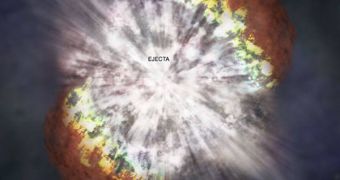In new observations of the distant skies, astronomers managed to identify two supernova explosions that far exceeded any known record of age and distance. The Type IIn bodies were estimated to be approximately 11 billion years old, about two times more so than the previous record-holder, a supernova that exploded some six billion years ago. For the discovery, astronomers used telescope images of the same patch of the sky, taken from the same location, only annually for four years. They then spent a lot of time looking over the images and assessing any changes in the brightness of objects in them.
It's not rarely that experts manage to identify supernovas by their light signature. For example, if one were to look at a patch of sky for long enough, and have telescopic vision, they would see at one point a small dot of light becoming increasingly brighter, reaching an apex point, and then reducing its luminosity over time. The exact same principle was used by University of California in Irvine (UCI) Astronomer Jeff Cooke, the leader of the new study, who looked at a certain space region using the Canada-France-Hawaii Telescope every year.
In the investigations, the team determined that two of the dots that increased in brightness over the four-year period of the study were, in fact, supernovas of the very rare type IIn. “The universe is about 13.7 billion years old, so really we are seeing some of the first stars ever formed,” Cooke said, quoted by Space. When the Cosmos first formed, there were no stars, as they only differentiated later. But the light from these two bodies, which is only now hitting us, comes from stars that were formed only 2.7 billion years after the Big Bang, maybe even sooner.
“When stars explode, they spew matter into space. Eventually, gravity collapses the matter into a new star, which could have planets such as Earth around it,” Cooke added. Supernovas, regardless of their type, usually form when massive stars, having 50 to 100 times the mass of the Sun, collapse on themselves. Despite expelling most of their materials before they go, the stars still have sufficient energy to cause an unbelievably large explosion, which is regularly accompanied by important radiation emissions, such as X-rays and gamma-rays.

 14 DAY TRIAL //
14 DAY TRIAL //